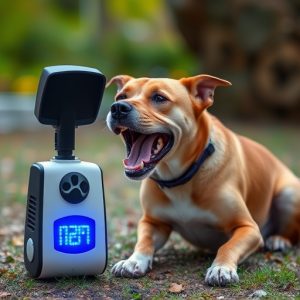Safe Sonic Deterrents: Training Dogs with Ultrasonic Frequencies
Dogs have exceptional hearing, making safe ultrasonic frequencies (22-45 kHz) an effective and human…….
Dogs have exceptional hearing, making safe ultrasonic frequencies (22-45 kHz) an effective and humane method for dog control. These inaudible sounds deter dogs without causing harm, ideal for walking protection in residential, commercial, or public spaces. Sonic deterrents, strategically placed and consistently used, encourage positive behavior through positive reinforcement training. This approach replaces traditional, potentially harmful methods, appealing to pet owners concerned about their pets' safety and well-being.
“Explore a innovative and safe approach to canine control with sonic dog deterrents, your walking companion against unwanted behavior. This comprehensive guide delves into the science behind ultrasonic frequencies, their positive impact on training, and effective implementation tips.
Learn how these devices leverage nature’s tools, offering a humane alternative to traditional methods. Understand dog behavior, the technology’s mechanism, and gain insights to train your pet to respond positively to sonic deterrents, ensuring peaceful walks for both you and your four-legged friend.”
- Understanding Dog Behavior and Their Sense of Hearing
- The Science Behind Ultrasonic Frequencies for Dog Deterrence
- Safe and Effective Implementation: Placement and Usage Tips
- Advantages Over Traditional Methods: Why Choose Ultrasonic Technology?
- Training Your Dog to Respond Positively to Sonic Deterrents
Understanding Dog Behavior and Their Sense of Hearing
Dogs have an exceptional sense of hearing, much more sensitive than that of humans. They can detect sounds at higher frequencies and from farther distances. This heightened auditory ability plays a significant role in their behavior and communication. When it comes to deterrents, understanding how dogs perceive sound is crucial for effective and safe control methods.
Safe ultrasonic frequencies specifically designed for dog control leverage this natural sensitivity without causing harm. These high-frequency sounds are above the range of human hearing but within the audible spectrum for canines. By emitting these ultrasonic tones, devices can gently alert dogs to their presence, triggering a conditioned response to avoid the area. This approach ensures that dogs are deterred without experiencing any physical discomfort or distress, promoting a humane and effective walking protection solution.
The Science Behind Ultrasonic Frequencies for Dog Deterrence
The Science Behind Ultrasonic Frequencies for Dog Deterrence involves leveraging specific sound waves that are inaudible to humans but disruptive to canine hearing. Safe ultrasonic frequencies for dog control range typically between 22,000 and 45,000 Hz—well above the human hearing range of approximately 20 Hz to 20,000 Hz. When these high-frequency sounds are emitted, they create a sensation of discomfort or even pain in dogs, encouraging them to avoid the area. This technology is designed to be humane and non-violent, as it does not cause physical harm but rather modifies behavior through auditory cues that dogs find unpleasant.
The effectiveness of ultrasonic dog deterrents stems from the sensitivity of a dog’s hearing. Dogs can detect sounds at much lower decibels than humans, making them receptive to high-frequency tones. By targeting these frequencies, the devices can be effectively used for walking protection, deterring dogs from approaching or intruding on specific areas without scaring or harming them. This makes it a popular and safe alternative for managing dog interactions in residential, commercial, and public spaces.
Safe and Effective Implementation: Placement and Usage Tips
When implementing a sonic dog deterrent, safety and effectiveness should be at the forefront of your considerations. Utilizing safe ultrasonic frequencies specifically designed for dog control is paramount. These devices emit high-pitched sounds that are inaudible to humans but disruptive to dogs, encouraging them to steer clear. Placement is key; strategically position the deterrents near areas where dogs tend to trespass, such as gardens or patios. Keep them away from human living spaces to ensure no discomfort for homeowners. Regular usage involves activating the device when needed, allowing it to emit the ultrasonic sound that will gently but firmly chase away any canine intruders. Remember, consistency and correct placement are vital for optimal results.
To make these deterrents even more effective, consider combining them with positive reinforcement training for your own dog. This ensures a safe and harmonious environment for all residents and pets in the household or neighborhood. Always follow manufacturer guidelines regarding battery usage and device maintenance to guarantee longevity and continued effectiveness.
Advantages Over Traditional Methods: Why Choose Ultrasonic Technology?
The traditional methods of dog deterrence often involve harsh chemicals, loud noises, or even electric shocks, which can be detrimental to both the animal’s well-being and the environment. This has led many pet owners and advocates to seek alternative solutions. Ultrasonic technology for dog control offers a safe and humane approach. These devices emit high-frequency sound waves that are inaudible to humans but irritant to dogs, encouraging them to avoid certain areas without causing physical harm.
Choosing ultrasonic technology as a dog deterrent provides several advantages. Firstly, it is environmentally friendly, eliminating the need for chemicals or electrical components. Secondly, it is completely harmless to humans and other pets, making it a safe option for households with children or multiple species. Moreover, ultrasonic dog deterrents are effective in various settings, from homes and gardens to public spaces, offering a versatile solution for dog owners seeking to protect their walking routes. Safe ultrasonic frequencies ensure that this technology can be employed without worry, providing peace of mind for both pet owners and the community.
Training Your Dog to Respond Positively to Sonic Deterrents
Training your dog to respond positively to sonic deterrents is a crucial step in ensuring their safety and effectiveness. It’s important to introduce these devices gradually, starting with low-intensity settings and positive reinforcement when they show no reaction. This helps dogs associate the ultrasonic frequencies—which are safe and inaudible to humans—with neutral or positive experiences rather than fear or discomfort.
When training, keep sessions short and frequent. Use treats and praise as rewards for calm behavior during exposure to the deterrent. Consistency is key; regular practice will help your dog generalize their response across different environments. Remember to choose a device that operates within safe ultrasonic frequencies for dog control, typically between 22-50 kHz, to avoid any potential harm to your pet’s sensitive hearing.
The safe and effective use of ultrasonic frequencies for dog control offers a modern, non-violent approach to managing canine behavior. By understanding dog senses and leveraging science, these sonic deterrents provide a peaceful solution for both pets and their owners. With proper implementation and training, ultrasonic technology can revolutionize how we address unwanted dog activities, making it an appealing choice for those seeking a humane and efficient method of dog control.


